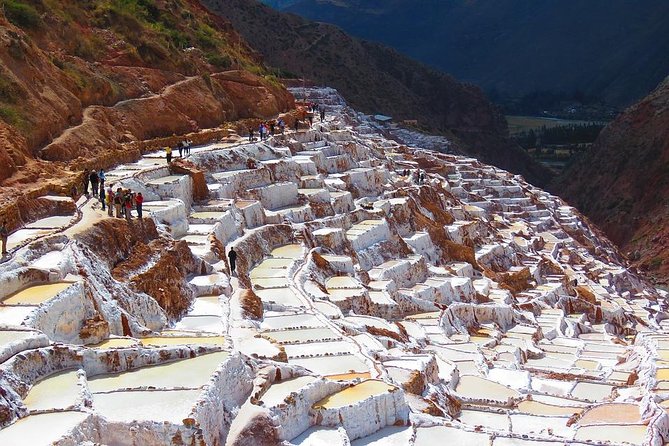The Maras Salt Mines in Peru are a fascinating and historically significant site, offering a unique glimpse into ancient salt extraction methods and the cultural heritage of the region. Here’s a detailed and expanded guide covering everything you need to know about the Maras Salt Mines:
1. Location and Accessibility:
- Geographical Setting: The Maras Salt Mines are located in the Sacred Valley of the Incas, near the town of Maras, about 40 kilometers north of Cusco.
- Access Routes: Visitors can reach Maras by various means, including guided tours, private transportation, or even hiking. The site is often included in Sacred Valley tours alongside other notable attractions.
2. Historical Significance:
- Ancient Origins: The salt mines date back to pre-Inca times and were expanded during the Inca Empire. The method of salt extraction used today remains largely unchanged from the techniques employed by the ancient inhabitants of the region.
- Cultural Heritage: The salt pans are not only a testament to the ingenuity of the Inca people but also a living cultural heritage, as the salt extraction methods have been passed down through generations.
3. Salt Extraction Process:
- Natural Springs: The salt pans are fed by a natural spring that emerges from the mountainside. This spring carries salty water, which is directed into an intricate network of shallow pools constructed on the hillside.
- Evaporation and Crystallization: As the water evaporates under the high-altitude sun, salt crystals form at the bottom of the pools. Local families, known as “salineros,” carefully harvest the salt by hand, a practice that has been maintained for centuries.
- Terraced Layout: The salt pans are arranged in a terraced fashion, creating a visually stunning patchwork on the mountainside.
4. Panoramic Views and Photography:
- Scenic Landscape: The Maras Salt Mines provide a stunning visual spectacle with their terraced pools contrasting against the natural surroundings of the Andes mountains. The panoramic views from the site are particularly breathtaking.
- Photography Opportunities: Photographers and enthusiasts will find ample opportunities to capture the geometric patterns of the salt pans, especially during the late afternoon when the sunlight enhances the textures and colors.
5. Cultural Interaction:
- Local Salineros: Interact with the local salineros, who are often happy to share their knowledge and experiences related to salt extraction. Some tours may even offer the chance to participate in the harvesting process, providing a hands-on cultural experience.
- Community Connection: The Maras Salt Mines are operated by the local community, and a visit to the site contributes to the sustainable development of the region. Purchasing locally-produced salt or crafts supports the livelihoods of the salineros.
6. Inca Agricultural Terraces:
- Moray Agricultural Terraces: Combine your visit to the Maras Salt Mines with a trip to the nearby archaeological site of Moray. Moray features impressive concentric agricultural terraces believed to have been an experimental agricultural laboratory for the Inca Empire.
7. Local Artisanal Market:
- Maras Market: Explore the local market in the town of Maras, where you can find handmade crafts, textiles, and locally produced goods. It’s an opportunity to engage with the community and purchase authentic Peruvian souvenirs.
8. Tour Options:
- Guided Tours: Various tour operators offer guided tours to the Maras Salt Mines, providing insights into the history, culture, and salt extraction process. Guides often share fascinating stories about the significance of the site.
- Self-Guided Exploration: For those seeking a more independent experience, it’s possible to explore the salt pans on your own. However, a guide can enhance the visit by offering a deeper understanding of the cultural and historical context.
9. Best Time to Visit:
- Dry Season: The dry season (May to October) is typically the best time to visit the Maras Salt Mines. During these months, the weather is clear, and the salt pans are at their most vibrant. However, the site is accessible year-round.
10. Cultural and Sustainable Tourism:
- Responsible Visitation: As with any tourist destination, practicing responsible and sustainable tourism is essential. Respect local customs, minimize environmental impact, and support initiatives that contribute to the well-being of the local community.
- Educational Aspect: Visiting the Maras Salt Mines not only offers a visually stunning experience but also serves as an educational opportunity to understand the importance of preserving cultural practices and sustainable livelihoods.
11. Practical Tips:
- Footwear: Wear comfortable and sturdy footwear, especially if you plan to explore the terraced salt pans. The terrain can be uneven, and proper shoes will enhance your comfort.
- Sun Protection: Due to the high-altitude location, sun protection is crucial. Bring sunscreen, a hat, and sunglasses to shield yourself from the strong mountain sun.
- Local Cuisine: Take advantage of the local gastronomy in Maras and nearby towns. Sample traditional Peruvian dishes made with locally sourced ingredients.
12. Connecting with Other Sites in the Region:
- Ollantaytambo: Extend your journey by visiting Ollantaytambo, another historical site in the Sacred Valley. Explore the well-preserved Inca ruins and the charming cobblestone streets of this ancient town.
- Pisac: Further enrich your experience by exploring the archaeological site of Pisac, known for its agricultural terraces, ceremonial center, and vibrant artisan markets.
In summary, the Maras Salt Mines offer a captivating blend of history, culture, and natural beauty. Whether you’re intrigued by ancient Inca techniques, seeking panoramic views of the Andes, or interested in cultural interactions, a visit to the salt pans provides a memorable and enriching experience in the heart of the Sacred Valley.

